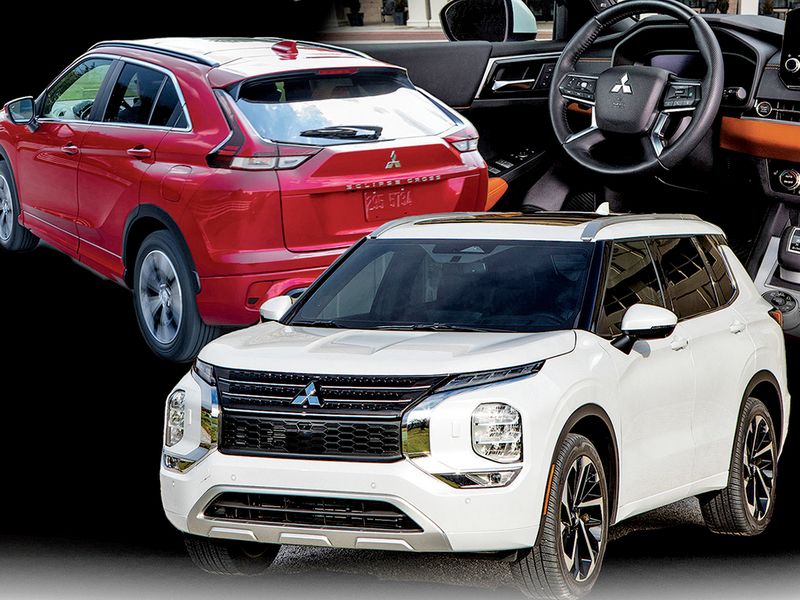
Mitsubishi Motors’ last halo vehicle was a turbocharged, all-wheel-drive sedan with 303 hp that exited the market as the 2015 Lancer Evolution Final Edition, selling for about $40,000 with shipping. The shine was off the aging “Evo” by the time it was discontinued, but dealers fondly remember the excitement it brought the brand.
The automaker’s newest halo vehicle is a three-row crossover that also draws $40,000 transaction prices and is once again bringing energy back to the Mitsubishi name — along with a wealthier clientele more concerned with fresh product than distressed pricing.
Mitsubishi dealers are breathing a sigh of relief since the April arrival of the 2022 Outlander after years of discounting mature products, such as the outgoing Outlander compact and the decade-old Outlander Sport subcompact. The new Outlander is based on the redesigned Nissan Rogue, which doesn’t offer a third row of seating.
The launch also coincides with strong demand across the U.S. auto market amid tight supplies from the global chip shortage.
“The new Outlander is the nicest Mitsubishi we’ve seen in years,” said Ryan Gremore, president of O’Brien Auto Team in Bloomington, Ill. “That has nicely parlayed itself with market conditions and it’s selling very well.”
New Outlanders were selling on O’Brien Mitsubishi’s website last week at prices that ranged from about $30,000 with shipping to $43,000.
Not only is the new-gen Outlander selling at full sticker, but given current market conditions, so are the brand’s other models. Mitsubishi executives say that the company has put money into the older models to keep them fresh. The Eclipse Cross was just freshened, the Mirage hatch and sedan have new body panels, and all models have added safety and tech features.
“There’s nothing to apologize for with this Eclipse Cross,” Ken Konieczka, vice president of sales operations at Mitsubishi Motors North America, told Automotive News.
As part of the mid- cycle freshen for the Cross, Mitsubishi restyled the rear end to remove a light bar that bisected the rear window and gave the vehicle an awkward appearance. The manufacturer removed an unpopular touchpad interface for the infotainment system in favor of a touch screen. The Outlander Sport was mildly freshened for the 2020 model year.
The jump in transaction prices across the lineup has been a boon to Mitsubishi dealers, who are now reporting much higher profits than in recent years when the brand had to offer incentives to move vehicles off the lot. Mitsubishi announced 10 new franchisees in April, including new outlets in Redondo Beach, Calif., and Houston.
The brand’s first-quarter sales more than doubled compared with the pandemic-hit period last year. Mitsubishi reported its best-ever retail sales in June for the Outlander and Eclipse Cross. Deliveries in the first half of 2021 were higher by 12 percent compared with 2020, though the 53,377 deliveries were still less than same period in 2019.
“The Outlander has come out of the gate on fire,” said Mark Chaffin, COO at Mitsubishi Motors North America. “It’s been a long time since Mitsubishi had that level of energy, excitement for a new product.”
While the dealers are celebrating Mitsubishi’s new products and profits, they continue to worry about the brand’s future. The new-generation Outlander is a big hit, but it’s one vehicle being sold in a unique supply-and-demand climate, some retailers point out. When those forces are more balanced, Mitsubishi will be at a disadvantage once again.
The Outlander Sport, despite some freshening here and there, is still in its first generation that dates back to the 2011 model year. The Mirage last underwent a redesign for the 2014 model year.
“Half the battle is the product. The new Outlander proves that,” said Ayman Moussa, CEO of Carnamic auto group in the San Francisco Bay Area. “Consumers have a low loyalty rate, so if the product is available and they like it, that is step No. 1.”
Moussa said he appreciates the Outlander redesign and the heavy freshen of the Eclipse Cross that has made it a more attractive vehicle. And shoppers coming to see the Outlander at his three Mitsubishi stores have higher credit scores and better trade-ins than previous buyers. The same is true generally for the 2022 Eclipse Cross.
But that leaves the other half of the Mitsubishi lineup sitting in limbo. With just four models.
“Mitsubishi has to basically revamp half the lineup for us to be competitive, and I don’t see that happening,” Moussa said. “Not in the near future at least.”
The only fresh model that dealers have been promised is a plug-in hybrid version of the redesigned Outlander. The current Outlander plug-in is based on the previous generation from the 2014 model year.
A few years back, there was hope among dealers that an entirely new lineup of Mitsubishi products could be built on Nissan platforms. But turmoil within the Renault-Nissan-Mitsubishi alliance damped that enthusiasm.
In Europe, Mitsubishi has said it will use Renault platforms for new vehicles, but those are unlikely to come to the U.S.
Mitsubishi’s product road map — presented as part of its financial results for the 2020 fiscal year — references two new models after 2023 but offers no details. The brand has a new plug-in version of the Eclipse Cross and a planned redesign of its Triton pickup, but they are not for the U.S. market.
“There’s no other platform that we’re looking at in the near future with Mitsubishi,” said Gremore.
“You can’t survive on one new vehicle every 10 years. It’s not sustainable.”

